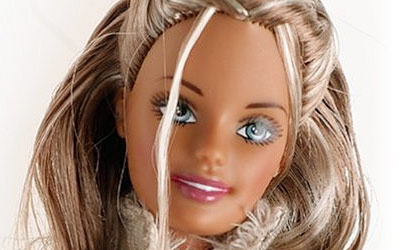Cali Girl
Barbie excellent earrings doll comes with play ear piercer, California beachwear, magazine, and accessories
 Barbie and friends are just like true California girls ready for another fun day in the sun. Dolls come with three color change marks for piercing holes in each ear. When water is rubbed on the ear with the cotton swab, the earring hole marks are revealed. Comes with an ear piercer to pierce the doll's ears. Once the ears are pierced each doll has sixteen pairs of earrings to create a special look. Barbie, Christie and Summer look great in their every day California beachwear and accessories. Each doll also comes with a new magazine, a publication all about life near the beach.
Barbie and friends are just like true California girls ready for another fun day in the sun. Dolls come with three color change marks for piercing holes in each ear. When water is rubbed on the ear with the cotton swab, the earring hole marks are revealed. Comes with an ear piercer to pierce the doll's ears. Once the ears are pierced each doll has sixteen pairs of earrings to create a special look. Barbie, Christie and Summer look great in their every day California beachwear and accessories. Each doll also comes with a new magazine, a publication all about life near the beach.
History of Ear Piercing
Ear piercing, a practice that dates back thousands of years, has deep cultural and aesthetic significance across various civilizations. From adornment to symbolism, ear piercing has held diverse meanings and played a role in personal expression and social identity. Let's explore the fascinating history of ear piercing, from its origins to its enduring popularity in contemporary times:
Ancient Beginnings: Ear piercing has roots in ancient cultures such as the Egyptians, Greeks, and Romans. In these societies, ear piercings were often a symbol of social status, wealth, and identity. Jewelry was used to accentuate the ears, and the types of earrings worn could convey specific meanings.
Traditional Practices: Indigenous cultures around the world, from Native Americans to African tribes, have practiced ear piercing for centuries. Earrings were crafted from materials like bone, shells, and stones, and they often held spiritual significance or conveyed membership in a particular tribe or group.
Medieval and Renaissance Eras: Ear piercing persisted through the Middle Ages and the Renaissance. During this time, earrings were worn by both men and women of various social classes. Pearls, gemstones, and intricate designs were popular choices for adornment.
Colonial Influence: Ear piercing practices were also influenced by colonial encounters. European explorers and traders introduced new styles of earrings to indigenous communities, leading to a fusion of traditional and imported jewelry designs.
Modern Resurgence: Ear piercing saw a resurgence in popularity during the 20th century. In the 1960s and 1970s, the counterculture movement embraced body piercing as a form of self-expression and nonconformity. By the 1980s, ear piercing became mainstream and accessible, with many people getting their ears pierced as a fashion statement.
Diversity of Styles: Modern ear piercing encompasses a wide variety of styles and placements. From traditional lobe piercings to cartilage piercings, helix piercings, and tragus piercings, individuals have the freedom to choose the placements and types of jewelry that best reflect their personal style.
Cultural and Spiritual Significance: Ear piercing continues to hold cultural and spiritual importance in many societies. In some cultures, piercings mark important life events, rituals, or transitions. In others, earrings are considered protective talismans or symbols of cultural identity.
Contemporary Trends: Today, ear piercing is a global phenomenon embraced by people of all ages, genders, and backgrounds. It has become a form of self-expression, allowing individuals to showcase their personalities, aesthetics, and affiliations through their choice of jewelry and piercings.
Professional Piercing Studios: With the emphasis on safety and hygiene, professional piercing studios provide a controlled environment for getting piercings. Trained piercers use sterile equipment and follow strict procedures to minimize risks and ensure a positive experience.
The history of ear piercing is a rich tapestry woven with cultural, social, and personal threads. From ancient origins to modern trends, the practice has evolved and adapted while retaining its significance as a form of adornment, self-expression, and cultural identity.
